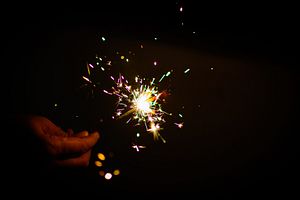In 2016, after the Hindu festival of Diwali, which is celebrated with lights and a lot of firecrackers, Delhi came under a thick haze of smog that lasted few days. Dense smog forced schools to be shut and authorities banned construction activities.
The major barometer for gauging air pollution is based on PM2.5 — particles in the atmosphere that are less than 2.5 microns in width, which are a major and common pollutant. The World Health Organization’s recommended limit on the average level of PM2.5 in 24 hours is 25 micrograms per cubic meter; the permissible limit for India is 60. Through 2016, Delhi’s air pollution level stood 29 times above WHO standards. Last year during Diwali, the highest level of PM2.5 was reported at 883.
Fittingly, the Supreme Court in India called for a ban on firecrackers on October 9 of this year, with a view toward bringing down the capital’s pollution levels. The ban had been imposed last year after the disastrous effects post-Diwali, but it was partially lifted in September 2017. In its 20-page judgment, a bench of three judges reverted to the ban, in a bid to test if a Diwali sans firecrackers could have a “positive effect” on the health of citizens.
Along with Greenpeace India, which welcomed the decision, environmentalists and citizens alike voiced their approval of the ban. But critics suggest the need to tackle the year-round pollution, contributed by Delhi’s vast number of vehicles, and the burning of crop stubble in neighboring states in autumn.
Another set of critics attempted to paint the ban on firecrackers as part of a communal picture. On social media, some alleged an “Islamic rule” and “targeting” of Hindu festivals. Controversial and yet popular writer Chetan Bhagat tweeted that Diwali is incomplete without firecrackers for children.
The Delhi spokesperson for the ruling, nationalist Bharatiya Janata Party (BJP), Tejinder Singh Bagga, announced his intention to distribute firecrackers worth INR 50,000 among slum children, stating that doing so wouldn’t violate the court order, “because the court has only banned the sale of firecrackers, it has not put a ban on buying or bursting them.”
Even as shopkeepers selling firecrackers expressed their disappointment with the ban, citing it to be a centuries-old legitimate activity, many of them discreetly sold firecrackers. A crackdown led to the seizure of 1,241 kg of firecrackers and arrest of 29 people. But nearly a week after the ban, the same bench of judges acknowledged the futility of such efforts, as purchases would have already taken place by then.
And the judges were right: on the night of October 19, the first day of Diwali, one of the monitoring stations of the Delhi Pollution Control Committee (DPCC) recorded PM2.5 at 978 micrograms per cubic meter at around 11 pm.
Clearly, communal emotions ruled over the health of lungs in Diwali this year. In 2015, a study had found about half of Delhi’s 4.4 million school children to have irreversible compromised lung capacity.
For many in Delhi – as well as for those in other cities in India – polluted air has become a way of life and has rendered children, the elderly, and stray animals helpless. Buying air masks seem more convenient than than taking logical actions.

































